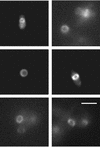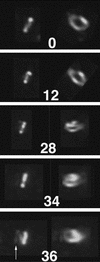FtsZ dynamics during the division cycle of live Escherichia coli cells
- PMID: 9555885
- PMCID: PMC107129
- DOI: 10.1128/JB.180.8.2050-2056.1998
FtsZ dynamics during the division cycle of live Escherichia coli cells
Abstract
The dynamics and assembly of bacterial cell division protein FtsZ were monitored in individual, growing and dividing Escherichia coli cells in real time by microculture of a merodiploid strain expressing green fluorescent protein (GFP)-tagged FtsZ. Cells expressing FtsZ-GFP at levels less than or equivalent to that of wild-type FtsZ were able to grow and divide over multiple generations, with their FtsZ rings visualized by fluorescence. During the late stages of cytokinesis, which constituted the last one-fourth of the cell cycle, the lumen of the FtsZ ring disappeared as the whole structure condensed. At this time, loops of FtsZ-GFP polymers emanated outward from the condensing ring structure and other unstable fluorescent structures elsewhere in the cell were also observed. Assembly of FtsZ rings at new division sites occurred within 1 min, from what appeared to be single points. Interestingly, this nucleation often took place in the predivisional cell at the same time the central FtsZ ring was in its final contraction phase. This demonstrates directly that, at least when FtsZ-GFP is being expressed, new division sites have the capacity to become fully functional for FtsZ targeting and assembly before cell division of the mother cell is completed. The results suggest that the timing of FtsZ assembly may be normally controlled in part by cellular FtsZ concentration. The use of wide-field optical sectioning microscopy to obtain sharp fluorescence images of FtsZ structures is also discussed.
Figures






References
-
- Addinall S G, Cao C, Lutkenhaus J. Temperature shift experiments with an ftsZ84(Ts) strain reveal rapid dynamics of FtsZ localization and indicate that the Z ring is required throughout septation and cannot reoccupy division sites once constriction has initiated. J Bacteriol. 1997;179:4277–4284. - PMC - PubMed
-
- Addinall S G, Lutkenhaus J. FtsZ-spirals and -arcs determine the shape of the invaginating septa in some mutants of Escherichia coli. Mol Microbiol. 1996;22:231–237. - PubMed
-
- Agard D A, Hiraoka Y, Shaw P, Sedat J W. Fluorescence microscopy in three dimensions. Methods Cell Biol. 1989;30:353–377. - PubMed
Publication types
MeSH terms
Substances
LinkOut - more resources
Full Text Sources
Other Literature Sources

